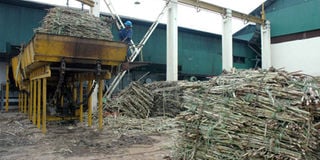Sugarcane exposing Busoga to famine

Sugarcane is loaded for crashing at a factory. Farmers in Busoga are increasingly abandoning food production for sugarcane growing. Photo By Stephen Wandera
What you need to know:
Food insecure. With the absence of a law on how much land one should reserve for domestic food production, many farmers in Busoga region are engaging more in sugarcane growing and ignoring food production. Despite its relatively fertile soils and good climate, Busoga comes second to Karamoja in food insecurity.
JINJA.
On June 22, vehicles belonging to Resident District Commissioners (RDCs), LC5 chairpersons and Members of Parliament from Busoga snaked through Kakira Town to Kakira Main Hall, the venue of a meeting called by Jinja RDC Richard Gulume to discuss the food insecurity in Busoga.
Iganga District Woman MP Olivia Kwagala Kabale was quick to lay the blame for the situation on the government, which she faulted for licensing so many sugar mills to operate in the region.
“The government is deliberately licensing these sugar factories to operate in Busoga, therefore it should take all the blame for the threat of famine and whatever else shall happen,” she said.
Backed by Mayuge District boss Omar Bongo, Ms Kabale observed that the issuance of the licences contravened the National Sugar Policy, which prohibits opening of new sugar mills within less than 25km of existing ones.
The policy also requires new mills to own at least 500 acres of sugarcane before commencing operations, provisions which were not observed when GM Sugar, Mayuge Sugar Industries and Sugar And Allied Industries Limited were granted operating licences.
Coming at a time when the same politicians have been clamouring for special development packages, like the Peace Recovery and Development to kick start social and economic development in Busoga, the attack sounded both funny and contradictory. Why?
One would have thought that the many sugar mills would have a multiplier effect on Busoga’s economy by increasing opportunities for direct and indirect employment, and improvements in health and education through the firms’ corporate social responsibility packages.
But the leaders argue that more land is being allocated to sugarcane growing, leaving tiny holdings that cannot allow for sustainable food production.
Mayuge RDC Margaret Mbeiza argues that landowners have gone to the extent of digging up graveyards to free up more land for sugarcane production.
Digging up of graves is an abomination in Busoga. The many rituals and animal sacrifices required of whoever treads that way, are testimony of the level of abhorrence that it attracts. Why then would one be willing to go that way?
Sweet cash
The chairman of the Busoga Sugarcane Out-growers’ Association, Mr David Ojwang Omboko, says Kakira Sugar Works pays Shs74,000 per ton of sugarcane and an annual bonus of Shs12,000 per ton supplied.
With each acre yielding 40 tons every 15 to 18 months, the farmer earns Shs3.4 million per acre (Shs2.9 million cash and a bonus of Shs480,000).
On the other hand, maize farmers Erias Timuntu and Denis Nyiro say they get six tons of maize over the same period, which at the current price of Shs600 per kilogram translates into Shs3.6 million.
That is much more than what a sugarcane farmer earns, but maize production is capital and labour intensive and far riskier given the lack of a price control mechanism.
“We plough once, but weed twice. The second rains usually come when we are harvesting so there is a lot work. Harvesting, drying the crop and planting for the second season have to be done simultaneously. The price is also often determined by business and not us,” Mr Nyiro says.
Mr Omboko says it is different with sugarcane.
‘Sugarcane is neither labour nor capital intensive and by the time a season begins we know what we are going to earn. There is definitely more money in sugarcane,” he says.
This, perhaps, explains why farmers are finding money from the sugarcane sweeter than sugar. In the absence of a law on how much land one should reserve for domestic food production, the onus of pushing for such a law is falling on the local politicians whose houses the locals descend on whenever any form of scarcity creeps in.
Jinja LC5 chairman Fredrick Ngobi Gume says local governments must draw up ordinances to regulate the sugar business. The problem though is that previous attempts have failed.
Bills rejected
In January Luuka District Councillors threw out the Production Bill 2012 and the District Sugarcane Out-growers Bill 2012, both of which had sought to, among other things, bar those with holdings of less than 2 acres from engaging in sugarcane production.
What is it that makes Mr Gume believe that the same councillors and those from other districts will be more receptive?
“The stakes are higher now. This is about the whole of region. If home grown solutions are rejected, we shall have no choice, but ask the central government to come in,” Mr Gume says.
Busoga region is waiting for such a law to come into force, but the landowners are not. They continue to grow the cane despite the many warning bells.
State of food insecurity
According to Uganda food security outlook, 2009, 6.3 per cent of households are at any one time food insecure, 21.3 per cent are moderately food insecure, while 72 per cent are considered secure at all times.
This means that 6 million Ugandans are moderately food insecure, with more than a million in Karamoja alone, implying that 6 million Ugandans eat less than the recommended 2100 kilocalories daily.
Food insecurity is highest in Karamoja (20 per cent), Busoga comes second with 15 per cent and Bududa third with 11 per cent.
According to FAO, food security is achieved when “all people, at all times, have physical, social and economic access to sufficient, safe and nutritious food which meets their dietary needs and food preferences for an active and healthy life”.
Source: Office of the Prime Minister




